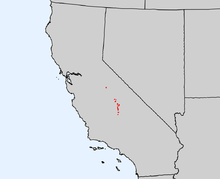Sequoiadendron giganteum
| Sequoiadendron giganteum | |
|---|---|
 |
|
| The "Grizzly Giant" tree in Mariposa Grove, Yosemite National Park | |
| Scientific classification | |
| Kingdom: | Plantae |
| Division: | Pinophyta |
| Class: | Pinopsida |
| Order: | Pinales |
| Family: | Cupressaceae |
| Subfamily: | Sequoioideae |
| Genus: | Sequoiadendron |
| Species: | S. giganteum |
| Binomial name | |
|
Sequoiadendron giganteum (Lindl.) J.Buchh. |
|
 |
|
Sequoiadendron giganteum (giant sequoia; also known as giant redwood, Sierra redwood, Sierran redwood, Wellingtonia or simply Big Tree—a nickname used by John Muir) is the sole living species in the genus Sequoiadendron, and one of three species of coniferous trees known as , classified in the family Cupressaceae in the subfamily Sequoioideae, together with Sequoia sempervirens (coast redwood) and Metasequoia glyptostroboides (dawn redwood). The common use of the name sequoia generally refers to Sequoiadendron giganteum, which occurs naturally only in groves on the western slopes of the Sierra Nevada Mountains of California.
The etymology of the genus name has been presumed—initially in The Yosemite Book by Josiah Whitney in 1868—to be in honor of Sequoyah (1767–1843), who was the inventor of the Cherokee syllabary. An etymological study published in 2012, however, concluded that the name was more likely to have originated from the Latin sequi (meaning to follow) since the number of seeds per cone in the newly-classified genus fell in mathematical sequence with the other four genera in the suborder.
Giant sequoias are the world's largest single trees and largest living thing by volume. Giant sequoias grow to an average height of 50–85 m (164–279 ft) and 6–8 m (20–26 ft) in diameter. Record trees have been measured to be 94.8 m (311 ft) in height. Claims of 17 m (56 ft) diameter have been touted by taking an author's writing out of context, but the widest known at chest height is closer to 8.2 m (27 ft). Between 2014 and 2016, specimens of coast redwood were found to have larger trunk diameters than all known giant sequoias.
The oldest known giant sequoia based on ring count is 3,500 years old. Giant Sequoias are among the oldest living things on Earth. Sequoia bark is fibrous, furrowed, and may be 90 cm (3.0 ft) thick at the base of the columnar trunk. It provides significant fire protection for the trees. The leaves are evergreen, awl-shaped, 3–6 millimetres (0.12–0.24 in) long, and arranged spirally on the shoots. The seed cones are 4–7 centimetres (1.6–2.8 in) long and mature in 18–20 months, though they typically remain green and closed for up to 20 years; each cone has 30–50 spirally arranged scales, with several seeds on each scale, giving an average of 230 seeds per cone. The seed is dark brown, 4–5 millimetres (0.16–0.20 in) long and 1 millimetre (0.039 in) broad, with a 1-millimetre (0.039 in) wide, yellow-brown wing along each side. Some seeds are shed when the cone scales shrink during hot weather in late summer, but most are liberated when the cone dries from fire heat or is damaged by insects.
...
Wikipedia

